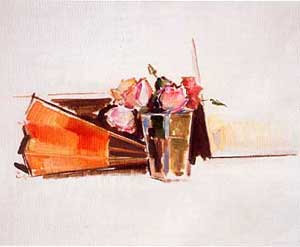Ramón Gaya
The painter in the cities
Ramón Gaya was born on 10 October 1910 in Murcia. At the age of ten he left school to devote himself wholly to painting, with his father’s backing and on the advice of the Murcian artists Flores and Garay. The arrival in Murcia of the British artists Tryon and, later, Japp and Hall, was providential for the young Gaya, since they brought with them reproductions of the French Impressionists and the kind of painting being done in Paris by Picasso, Braque and Matisse, which was his first contact with the modern world. In 1926 the poet Jorge Guillén also came to Murcia and, together with Juan Guerrero Ruiz, founded the magazine Verso y Prosa, to which Gaya contributed texts and paintings. In 1928 he obtained a grant to travel to Paris, where the excitement of finding himself with the avant-gardes that he already knew from photographs was only matched by the disappointment he felt on seeing them at close quarters, with the result that he turned his gaze to the Louvre and, above all, the Prado, “his” museum, where he found those who were to become his reference-points in painting and his mentors for seventy years: Titian, Rembrandt, Velázquez, Rubens, and all those who have gradually and naturally constructed his pictorial world. In 1933 he returned precipitately to Spain and settled in Madrid, there enrolling in a scheme for popular education, the Teaching Missions, with which he travelled around Spain from place to place, in the company of Rafael Dieste, Luis Cernuda and Antonio Sánchez Barbudo. The war brought about a dramatic interruption in his life and work. Like so many intellectuals, from the outset he placed himself at the service of the Republic, which singled him out on the literary and artistic fronts that served it both for propaganda and for moral support, and thus we see him taking a very active part in the legendary Valencian magazine Hora de España, as its only illustrator, alongside Antonio Machado, Dieste himself, Gil-Albert, María Zambrano, Bergamín and Luis Cernuda. After the war and the bitter experience of a refugee camp in France, he set off for Mexico, where he remained for fourteen years, and there he began to produce his now celebrated “Tributes”, in which the cherished masters, from Titian to Picasso, from Velázquez to Van Gogh, from Rembrandt to Hokusai, have a central, explicit role in many of his paintings. In 1956 he shifted his place of exile from Mexico to Italy and settled in Rome, leading a solitary life apart, shared for some years with the friendship of María Zambrano, the sculptor Giacomo Manzú and the writer Elena Croce. In 1960 Gaya’s life in Spain gradually began to return to normal with increasingly frequent and prolonged visits, first to Barcelona and then to Valencia, where he set up a studio in 1974. For him, those were years of intense work as a painter and a writer, for it was then that he wrote and published two of his most important books, El sentimiento de la pintura (1960) and Velázquez, pájaro solitario (1969). In 1984, without closing the studios that he had in Rome and in Valencia, Gaya went to live in Madrid, settling down to a pattern of constant movement which has taken him from Madrid to Paris, from Paris to Rome, and from Rome to Valencia or Murcia, in which latter city the museum that bears his name was inaugurated in 1990. The exhibition includes about two hundred works, with dates ranging from 1923 to the present, providing a wide-ranging retrospective of Ramón Gaya’s work and the influence that the cities where he has lived have had on him. The accompanying catalogue reproduces all the works in the exhibition and includes texts by Andrés Trapiello, Tomás Segovia and Juan Manuel Bonet.



